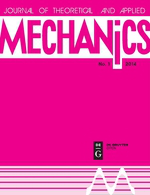
Journal of Theoretical and Applied Mechanics-Bulgaria
Scope & Guideline
Cultivating Knowledge in Mechanics for Tomorrow
Introduction
Aims and Scopes
- Theoretical Mechanics:
Research that delves into the fundamental principles and mathematical modeling of mechanical systems, including dynamics, statics, and fluid mechanics. - Applied Mechanics:
Studies focusing on the practical applications of mechanical theories in engineering fields, such as structural, thermal, and materials engineering. - Numerical Methods and Simulations:
Use of computational techniques to solve complex mechanical problems, including finite element analysis, computational fluid dynamics, and other simulation methods. - Experimental Mechanics:
Empirical investigations that validate theoretical models or numerical simulations through laboratory experiments and field studies. - Interdisciplinary Applications:
Research integrating mechanics with other fields, such as bioengineering, materials science, and environmental studies, to address contemporary challenges.
Trending and Emerging
- Nanomechanics and Nanomaterials:
There is a growing interest in the mechanics of nanomaterials and their applications, as evidenced by recent studies on nanoinclusions and their mechanical properties. - Biomechanics and Medical Applications:
Research focusing on the mechanical behavior of biological tissues and medical devices is gaining traction, highlighting the interdisciplinary nature of modern mechanics research. - Computational Mechanics and AI Integration:
The integration of artificial intelligence and machine learning techniques in computational mechanics is emerging as a significant trend, improving simulation accuracy and efficiency. - Sustainable Engineering Practices:
An increasing emphasis on sustainable engineering solutions, including studies on the environmental impact of materials and processes, is becoming more prevalent. - Dynamic Systems Analysis:
There is a notable trend towards exploring dynamic and time-dependent systems, particularly in relation to structural health monitoring and the analysis of transient phenomena.
Declining or Waning
- Classical Mechanics:
There has been a notable decrease in papers focusing solely on classical mechanics principles, as the journal shifts towards more interdisciplinary and applied themes. - Static Structural Analysis:
Research centered around traditional static analysis techniques is becoming less prominent, with a greater emphasis on dynamic and time-dependent behaviors. - Traditional Fluid Dynamics:
Papers strictly covering classical fluid dynamics are less frequent, as the focus has shifted towards more complex fluid interactions and advanced computational methods. - Basic Material Properties Studies:
Research primarily aimed at fundamental material properties without application context is declining in favor of studies that link material behavior to practical applications.
Similar Journals

Materials Physics and Mechanics
Innovating Insights in Physics and EngineeringMaterials Physics and Mechanics is a pivotal journal dedicated to advancing the fields of condensed matter physics, materials science, mechanical engineering, and the mechanics of materials. Published by the Institute of Problems in Mechanical Engineering, Russian Academy of Sciences, this journal has established itself as a valuable resource since its inception, particularly from 2003 to 2004 and now continuously from 2009 to 2024. Although it currently holds a Q4 categorization in various disciplines, its contributions are critical to understanding and developing new materials and their applications in engineering. The journal provides insightful articles that explore the nuances of material properties, their behaviors under different conditions, and the physical principles governing these phenomena. Though it operates under a traditional publication model, the insights provided within its pages are invaluable to researchers, professionals, and students striving to push the boundaries of knowledge in the materials domain. Its ISSN numbers (1605-2730, E-ISSN 1605-8119) serve as a gateway to a wealth of scientific knowledge emanating from the Russian Federation, contributing to the global discourse in materials physics and mechanics.
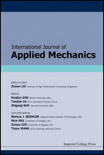
International Journal of Applied Mechanics
Exploring New Horizons in Materials ScienceThe International Journal of Applied Mechanics, published by World Scientific Publishing Co Pte Ltd, is a premier platform that serves the fields of materials science, mechanical engineering, and mechanics of materials. Located in Singapore, this journal has established itself as a crucial resource for researchers, professionals, and students, with its convergence of scholarly work from 2009 to 2024. Ranked in the Q2 category across notable disciplines, including Materials Science, Mechanical Engineering, and Mechanics of Materials, it reflects a strong commitment to publishing high-quality research that pushes the boundaries of knowledge in applied mechanics. Despite being a non-open access journal, its successful Scopus rankings, including an impressive rank of #151 in Mechanical Engineering, signify its substantial impact and recognition within the academic community. This journal not only aims to disseminate pioneering research but also to foster collaboration and innovation in the rapidly evolving landscape of applied mechanics.
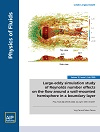
PHYSICS OF FLUIDS
Pioneering Discoveries in Fluid Flow and TransferPHYSICS OF FLUIDS is a premier journal published by AIP Publishing that serves as a vital resource for the fluid mechanics community. With an impressive impact factor and a consistent ranking in the Q1 quartile across multiple related disciplines—including Computational Mechanics, Condensed Matter Physics, Fluid Flow and Transfer Processes, Mechanical Engineering, and Mechanics of Materials—this journal is renowned for disseminating high-quality research in the dynamic field of fluid dynamics. Covering a wide range of topics, from fundamental fluid mechanics to advanced computational modeling, PHYSICS OF FLUIDS plays a crucial role in advancing understanding and fostering innovation in both academic and industrial applications. With its strong reputation and significant readership, this journal is essential for researchers, professionals, and students seeking to stay updated on the latest developments in fluid physics.

Journal of Applied Mechanics and Technical Physics
Advancing the Frontiers of Mechanics and PhysicsJournal of Applied Mechanics and Technical Physics is a distinguished publication that serves as a vital resource for researchers and professionals in the realms of mechanical engineering, mechanics of materials, and condensed matter physics. Published by MAIK NAUKA/INTERPERIODICA/SPRINGER, this journal has been committed to disseminating high-quality research since its inception in 1965. With a noted presence in the academic community, it holds a respectable Q3 ranking in multiple categories as of 2023, indicating its relevance and contribution to the field. Although it does not currently offer open access, the journal provides valuable insights and advancements through its rigorous peer-review process. Covering a broad spectrum of topics in applied mechanics and technical physics, it aims to foster innovation and dialogue among scientists, engineers, and scholars alike. Located in the United States, the journal continues to make significant strides in bridging the gap between theoretical research and practical applications, making it an essential read for anyone engaged in these dynamic fields.
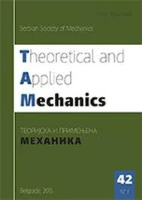
Theoretical and Applied Mechanics
Exploring Innovative Solutions in Theoretical Mechanics.Theoretical and Applied Mechanics is a premier open-access journal published by the Serbian Society of Mechanics, dedicated to advancing the fields of Applied Mathematics, Computational Mechanics, and Mechanical Engineering. Since its inception, this journal has provided a vital platform for researchers and practitioners to publish high-quality, peer-reviewed articles that contribute to our understanding of theoretical concepts and their practical implications in mechanics. With an ISSN of 1450-5584 and a growing international readership, Theoretical and Applied Mechanics aims to bridge the gap between theory and application, making significant strides in the engineering community. Although the journal is currently ranked in the Q4 category across its scopes, it encourages innovative research that fosters interdisciplinary collaboration. For those interested in exploring cutting-edge developments in the mechanics field, this journal offers an invaluable resource for researchers, professionals, and students alike.
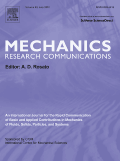
MECHANICS RESEARCH COMMUNICATIONS
Fostering Collaboration in Advanced Engineering StudiesMECHANICS RESEARCH COMMUNICATIONS, published by PERGAMON-ELSEVIER SCIENCE LTD, is a prestigious journal in the fields of Civil and Structural Engineering, Condensed Matter Physics, Materials Science, and Mechanical Engineering. With an ISSN of 0093-6413 and E-ISSN of 1873-3972, it has made significant contributions to the understanding and advancement of mechanics and materials since its inception in 1974. The journal is well-regarded in academia, holding a Q2 ranking across multiple categories as of 2023, and ranking in the 65th percentile for Mechanical Engineering. Researchers and professionals benefit from its peer-reviewed content, which includes a wide range of articles from fundamental research to applied technological developments. Although currently not an open access journal, it remains a vital resource for those focused on innovating within the engineering and materials science domains. With its established legacy, MECHANICS RESEARCH COMMUNICATIONS continues to shape the discourse in mechanics and engineering, making it essential reading for students and practitioners alike.

Journal of Theoretical and Applied Mechanics
Connecting Researchers and Practitioners in MechanicsJournal of Theoretical and Applied Mechanics, published by the Polish Society of Theoretical and Applied Mechanics, stands as a leading platform for disseminating cutting-edge research in the realms of theoretical and applied mechanics. With its ISSN 1429-2955 and E-ISSN 1429-2955, this Open Access journal has been fostering academic dialogue since 2006, making knowledge readily accessible to researchers and practitioners alike. Based in Warsaw, Poland, the journal encompasses a wide breadth of topics within mechanics, appealing to a diverse readership including researchers, professionals, and students. The journal's current Scopus ranking places it within the 30th percentile of the field, emphasizing its relevance and contribution to the discipline. As it converges from 2007 to 2024, the Journal of Theoretical and Applied Mechanics is pivotal for those seeking to advance understanding and innovation in mechanical engineering and mathematics, making it an essential resource for anyone involved in these critical areas of study.
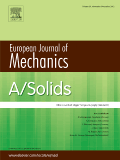
EUROPEAN JOURNAL OF MECHANICS A-SOLIDS
Pioneering Research in Mechanical EngineeringThe EUROPEAN JOURNAL OF MECHANICS A-SOLIDS, published by ELSEVIER and based in the Netherlands, stands as a premier outlet for research in the field of solid mechanics. With an impressive track record since its inception, the journal has been indexed in prestigious categories including Materials Science, Mechanical Engineering, and Mathematical Physics, achieving Q1 quartile status across these domains in 2023. This recognition underscores the journal's impact, with Scopus rankings placing it in the top echelon of its respective fields, such as #39 in General Physics and Astronomy and #116 in Mechanical Engineering, demonstrating its significance and wide-reaching influence in the academic community. Scientists, engineers, and researchers are encouraged to submit their cutting-edge findings in areas related to solid mechanics, contributing to the journal's mission of advancing knowledge and innovation in this vital discipline. The journal's comprehensive scope allows for interdisciplinary engagement, making it an essential resource for professionals and students alike seeking to explore the latest developments in mechanics of materials and related areas.

ACTA MECHANICA SINICA
Exploring the Depths of Mechanical and Computational ScienceACTA MECHANICA SINICA is a prestigious journal published by SPRINGER HEIDELBERG that has been a cornerstone in the field of mechanical engineering and computational mechanics since its inception in 1985. Based in Germany, this leading publication is internationally recognized for its high impact, holding a Q1 ranking in both Computational Mechanics and Mechanical Engineering as of 2023. It is positioned prominently within the academic community, evidenced by its respectable Scopus rankings—#21 in Computational Mechanics and #159 in Mechanical Engineering, both within the 76th percentile. Researchers and professionals alike turn to ACTA MECHANICA SINICA for cutting-edge research, innovative methodologies, and insights that drive advancements in the discipline. Although the journal is not open access, its rigorous peer-review process ensures the publication of high-quality, impactful research that is essential for scholars and practitioners aiming to stay at the forefront of mechanical engineering advancements.
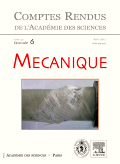
COMPTES RENDUS MECANIQUE
Unveiling Innovations in Mechanics for a Global AudienceCOMPTES RENDUS MECANIQUE, an esteemed journal published by the Académie des Sciences, serves as a critical platform for cutting-edge research in the fields of mechanics and materials science. With an ISSN of 1631-0721 and an E-ISSN of 1873-7234, this open-access journal has gained visibility since its transition to open access in 2020, encouraging a broader dissemination of knowledge within the community. As of 2023, it holds a Q3 ranking in both the Materials Science (Miscellaneous) and Mechanics of Materials categories, according to category quartiles. Given its Scopus rankings—299th out of 398 in Mechanics of Materials and 360th out of 463 in General Materials Science—it provides valuable insights and advancements in these disciplines. Located in Paris, France, the journal caters to researchers, professionals, and students alike, showcasing a diverse range of studies and developments that push the boundaries of knowledge in mechanics. Through its accessible format, COMPTES RENDUS MECANIQUE not only highlights significant findings but also promotes collaboration and innovation across the global scientific community.